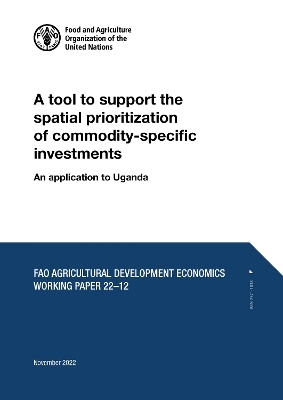
A tool to support the spatial prioritization of commodity-specific investments
an application to Uganda
Seiten
2023
Food & Agriculture Organization of the United Nations (FAO) (Verlag)
978-92-5-137165-7 (ISBN)
Food & Agriculture Organization of the United Nations (FAO) (Verlag)
978-92-5-137165-7 (ISBN)
This methodology supports Ugandan policymakers in selecting top targets for investment among the country's districts that have the potential to be agricultural leaders, but languish in poverty instead.
In this paper, proposes a simple methodology to select a limited number of geographical areas to prioritize for commodity-specific investments in Uganda. Similar to other approaches for prioritizing investments geographically, the basic idea behind the proposed method is that districts with high agro-ecological potential, that are also far from their potential and have high levels of poverty, should be prioritised for commodity-specific investments as they are where investments are likely to have the highest impact. The methodology then proposes an iterative elimination algorithm to provide a list of suggested districts that rank high in all dimensions. The results highlight that prioritized districts are very context and commodity specific. In certain cases (eg sugar cane or millet), prioritised districts tend to e highly concentrated in one geographical region, whereas they tend to be more spread out for the sectors producing other commodities (ie bananas, coffee, goats, cassava and maize). The results are expected to inform a discussion with policymakers in Uganda which is expected to culminate in the selection of an even narrower set of districts for which more in-depth analyses of commodity-specific investments will be undertaken at the level of priority areas, including , among others, irrigation, mechanisation, seeds and fertilisers
In this paper, proposes a simple methodology to select a limited number of geographical areas to prioritize for commodity-specific investments in Uganda. Similar to other approaches for prioritizing investments geographically, the basic idea behind the proposed method is that districts with high agro-ecological potential, that are also far from their potential and have high levels of poverty, should be prioritised for commodity-specific investments as they are where investments are likely to have the highest impact. The methodology then proposes an iterative elimination algorithm to provide a list of suggested districts that rank high in all dimensions. The results highlight that prioritized districts are very context and commodity specific. In certain cases (eg sugar cane or millet), prioritised districts tend to e highly concentrated in one geographical region, whereas they tend to be more spread out for the sectors producing other commodities (ie bananas, coffee, goats, cassava and maize). The results are expected to inform a discussion with policymakers in Uganda which is expected to culminate in the selection of an even narrower set of districts for which more in-depth analyses of commodity-specific investments will be undertaken at the level of priority areas, including , among others, irrigation, mechanisation, seeds and fertilisers
| Erscheinungsdatum | 02.03.2023 |
|---|---|
| Reihe/Serie | FAO agricultural development economics working paper |
| Zusatzinfo | col. figs, tables |
| Verlagsort | Rome |
| Sprache | englisch |
| Themenwelt | Wirtschaft ► Volkswirtschaftslehre ► Makroökonomie |
| Weitere Fachgebiete ► Land- / Forstwirtschaft / Fischerei | |
| ISBN-10 | 92-5-137165-2 / 9251371652 |
| ISBN-13 | 978-92-5-137165-7 / 9789251371657 |
| Zustand | Neuware |
| Haben Sie eine Frage zum Produkt? |
Mehr entdecken
aus dem Bereich
aus dem Bereich
Volkswirtschaftslehre für eine sich ändernde Welt
Buch | Hardcover (2024)
De Gruyter Oldenbourg (Verlag)
CHF 62,90
Kompakt und prüfungsrelevant für Wirtschaftswissenschaftler
Buch | Softcover (2021)
Vahlen, Franz (Verlag)
CHF 16,65
Makroökonomie, Wirtschaftspolitik und nachhaltige Entwicklung
Buch | Hardcover (2022)
Vahlen (Verlag)
CHF 69,70


